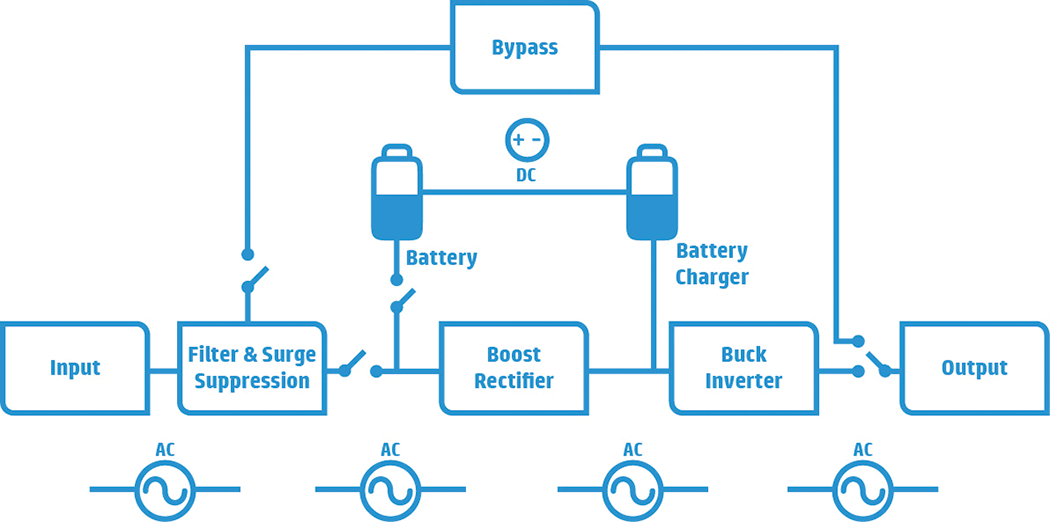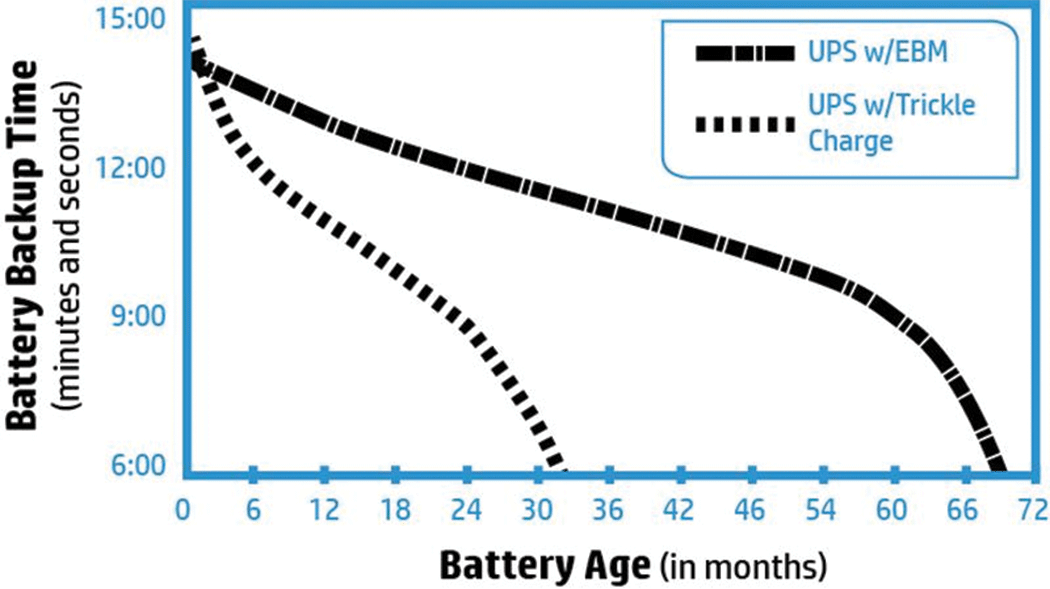David Chetham-Strode, WW Product Manager – Enterprise Infrastructure Solutions
HP
With space and energy conservation key topics among IT and facilities decision makers, UPS manufacturers are continually striving to design smaller products with fewer parts, lower cost, easier recycling and less weight. This delicate balance of innovative engineering combined with supply chain component and materials selection seeks to achieve a green energy solution, facilitating improvements in recycling, energy conservation and heat management.
Some UPSs now include energy-saving features such as real-time clocks (RTCs), which allow accurately timed, programmed shutdown and restart of protected devices even in the event of a power outage. Data center managers are discovering additional green advantages through the use of UPS power management software that is compatible in today’s energy-efficient virtualized environments. Still others are reaping the rewards from new UPS topologies that can contribute significantly to greener data centers.
One relatively new engineering design in power protection includes the minimally switched line-interactive (MST) UPS topology. This design abandons the use of voltage regulation transformers used in traditional line interactive topology UPSs to afford numerous advantages for users going green, and saving green.
Overall, MST UPSs offer a smaller environmental footprint via:
• Maximized power efficiency to use less energy,
• Longer battery life that diminishes recycling turns,
• Wise use of scarce commodity products,
• Better thermal management resulting in less strain on
cooling systems.
REDUCE
Less Is More – No More Heavy Transformers

Most line-interactive UPS topology designs rely on a large, low-frequency transformer to briefly buck- and boost-regulate fluctuating utility power to protected devices. Though using a voltage regulating transformer is sufficient for many applications, there are also many drawbacks, including unnecessary weight, use of costly and scarce commodity components (such as copper), jagged voltage regulation and excessive dependence on the UPS battery during the voltage-regulation phase.

On the other hand, minimally switched UPSs offer key advantages for IT managers looking to meet today’s green demands. This topology abandons the low frequency voltage transformer and its drawbacks and instead implements high-frequency magnetics and pulse-width-modulation switching power designs to maximize power efficiency and enhance battery life.
OPTIMIZE
No More Tap Dancing
When the utility line input changes above or below nominal levels (120 volts for example), the UPS compensates by either boosting up or bucking down the input voltage to regulate toward the ideal 120 volts. During this process, transformer-based line interactive UPS include several taps on the transformer, which doesn’t allow for a smooth resolution of voltage. These taps are similar to rungs on a ladder going up and down. The mechanical relays that switch from one tap (or rung) to another, either buck or boost the voltage. The regulation in this manner is typically +6/-10 percent between transitions, large steps. The drawback is that the number of taps is usually limited to a handful. With only a few taps available, the transition of going up or down is not continuous as these steps are fixed. The ratio from the input to output of this transformer therefore is based on how many of these taps are available making the resolution of this buck and boost somewhat rough. In addition, the mechanical relays included in these UPSs are notorious for their unpredictability.
MST topology overcomes these challenges with its high-frequency electronic/high-frequency switching. This advantage creates smooth and continuous, dynamic buck and boost regulation regardless of what the voltage variation is on the input. Digital technology within MST allows processing without mechanical switching. With MST, the dynamic electronic regulation is approximately +/- 2 percent. With no tap changing transformers or relays to switch, the design is comparable to a smooth escalator that can move up and down to the correct level as needed, with the added benefit of higher reliability.
Extended Battery Life and Less Recycling
A UPS functions as a bucket of energy that should be available when a power anomaly occurs. Yet frequently transferring to the battery for small utility variations degrades battery life and depletes that energy bucket. This occurs with traditional automatic voltage regulation (AVR) transformer-based line-interactive UPSs. As these UPSs change taps (device fitted to power transformers for regulation of the output voltage to required levels), switching one of the relays to a different tap on the transformer, the UPS first transfers to battery mode. Although the timing is brief, through these short instances, the life of the battery decreases.

Conversely, with MST technology, the UPS does not switch to battery for every small variation because digital technology allows processing without mechanical switching. The switching takes place at 20 kilohertz, including the charger and buck/boost. Taking care to not overburden the battery for minor changes in voltage can increase battery life from three years to as much as five years, resulting in a 66 percent increase that significantly helps reduce recycling waste and replacement costs.
Power and Cooling Efficiency
When it comes to efficiency, MST offers an attractive alternative to other UPS technologies (such as on-line double conversion) as it can help data center manager achieve more favorable power usage effectiveness (PUE). A prevalent statistic used in the industry, PUE is determined by dividing the amount of power entering a data center by the power used to run the computer infrastructure within it. This figure should be as close as possible to one (1.0), as it determines the energy efficiency of a data center. However, the average data center operates in the 2.0-plus range.
UPSs with MST technology achieve greater efficiency (in the 96 to 97 percent range) because there are few losses along the power train. As the name MST suggests, the switching devices are switched at a high frequency only when necessary and not all the time as in on-line double conversion UPSs. Consequently, the switching losses are minimal thus increasing the efficiency of MST based UPSs significantly.
Another key aspect to power efficiency in the data center includes achieving the optimum ambient temperature, which not only saves on cooling but also preserves the integrity of the computing systems. An MST UPS, with its special advanced battery management techniques, inherently generates less heat and has the unique ability to operate in higher ambient temperatures without the need for complex thermal management techniques. As a result, the UPS saves in cooling infrastructure and contributes to the overall PUE of the data center.
Additional Energy Saving Measures – Real Time Clock For the Energy Conscious
Another way that UPSs can help achieve energy savings is with features such as a real-time clock (RTC). RTCs allow accurately timed, programmed shutdown and restart of protected devices ensuring the UPS has the correct schedule shutdown and restart time. In many countries, there is concern about static power consumption in buildings, where after-hour, deserted desks with glowing computer screens underscore areas of energy waste. Using the UPS to shut the whole system down on a Friday evening and then power the system back up first thing on a Monday morning is one way to save energy.
INTEGRATE
Software Integration with Real Power Protection for Virtualized Environments
As IT managers have sought to efficiently use their physical devices and optimize their data centers and IT resources worldwide, many have turned to virtualization. Virtualization greatly simplifies physical IT infrastructures with the flexibility of allocating computer resources regardless of physical constraints. It also allows pooling, sharing and clustering on an as-needed basis, as well as the ability for servers to simultaneously run multiple, non-heterogeneous operating systems (OS) with numerous computing applications on each OS. Yet with this flexibility come greater complexity and the need for more robust backup systems in the event the power goes out. For this reason, power management software that integrates with minimally switched UPSs and protected devices is crucial.
During an extended power outage, the protection software can suspend each virtual machine sequentially before shutting down the host server. In this manner, all work-in-progress is protected, ensuring data integrity and saving potentially hundreds of thousands of dollars. The software intelligence spans facilities and geographical distances to manage the details of dealing with virtual environments and each of the applications on every server. Furthermore, the software monitors connected power devices, interfaces with the virtual management software, and in the event of an extended power failure, allows for proper planning and execution of an automatic, graceful shutdown to preserve IT investments.
CONCLUSION
Going green to save green is a global goal. Reducing weight, size, the use of expensive and non-replenishable materials, while optimizing efficiency and increasing battery life are all ways to make better use of energy. Overall carbon footprints are getting smaller as investments are made in sustainable equipment, which in turn help to preserve valuable IT investments. The greening of IT starts at the design phase and ends with the consumer having product choices to meet those energy-saving goals.







